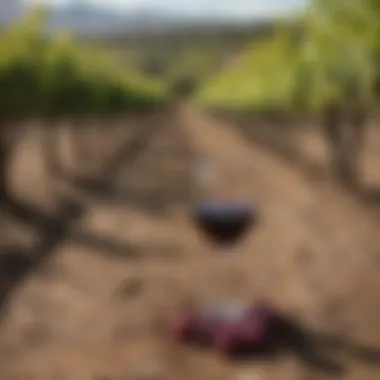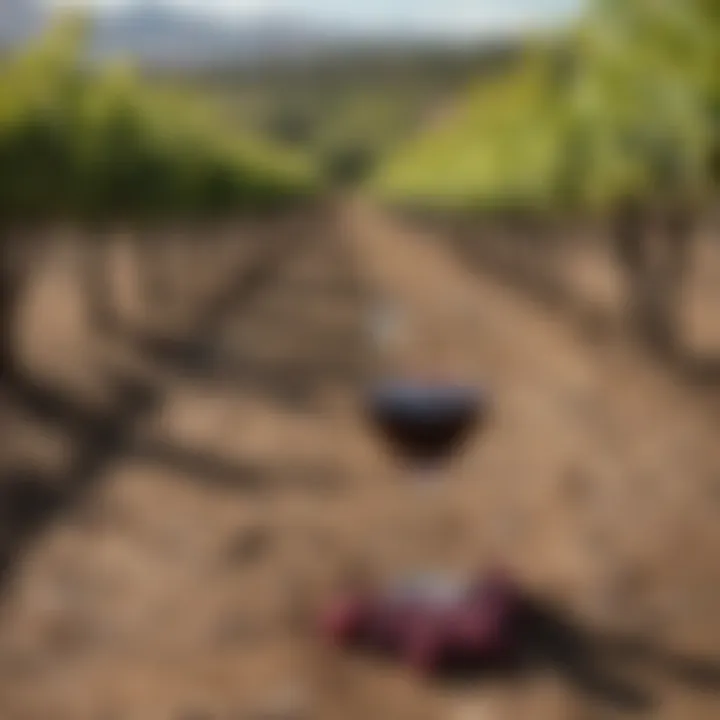The Quintessence of Malbec: Exploring Its Rich Depths


Intro
Malbec is a wine that has gained tremendous popularity in recent years. Its deep coloration, rich flavors, and smooth tannins have made it a favorite among many wine drinkers. The grape originated from France but found its true home in Argentina, where it flourished in the unique terroir the region offers. In this article, we will delve into the complexities of Malbec, exploring its origins, distinguishing characteristics, and the factors that contribute to its esteemed reputation. We will discuss the notable regions for Malbec production, the nuances of vintage variations, and the impact of winemaking techniques.
Understanding the essence of Malbec goes beyond just tasting the wine. It is a journey that includes exploring the history behind the grape, the culture surrounding it, and the ways it pairs with food. This guide will provide food lovers with a comprehensive analysis, enriching their appreciation of Malbec and enhancing their wine selection skills.
This exploration will not only highlight the key characteristics of Malbec but will also shed light on why it is a preferred choice among wine connoisseurs. From vintages to specific regions, let us unravel the charm and allure of this remarkable wine.
Understanding Malbec
Malbec is a wine that commands respect and admiration in the global wine community. Understanding Malbec is essential for any wine enthusiast, as it allows for deeper appreciation of its unique attributes and the nuances tied to its production. The history of Malbec, its geographical significance, and its evolution into the wine we know today all contribute to its status as a notable variety.
Historical Background
Malbec has its roots in France, where it originated in the Bordeaux region. It was primarily used as a blending grape in red wine production. The grape was known for its robustness and rich color but often showed variability in quality. In the 19th century, Malbec found its way to Argentina, which embraced and cultivated the grape under favorable conditions. Here, the grape flourished, capturing the attention of wine lovers globally with its distinctive characteristics.
As the Bordeaux region faced the phylloxera crisis in the late 19th century, Argentine vineyards became a refuge for Malbec. The grape adapted well to the high altitudes and temperate climates of Mendoza, leading to its rise as the flagship varietal of the country. Today, it is synonymous with Argentinian wine, marking a significant shift in its historical significance.
Geographical Distribution
Malbec is grown in several regions around the world, each contributing unique expressions of the grape. The most noteworthy locations include:
- Argentina: Particularly in Mendoza, where the high altitude and climate create optimal growing conditions.
- France: In the Cahors region, often referred to as "black wine" due to its deep color.
- United States: Regions like California and Washington State have begun to produce notable Malbec wines.
Each of these regions imparts distinctive traits to the wines produced, influenced by factors such as soil, climate, and winemaking techniques. This geographical diversity makes Malbec a fascinating subject of study for wine connoisseurs.
Malbec's Rise to Prominence
The transformation of Malbec from a minor component in Bordeaux blends to a star varietal in Argentina is remarkable. The popularity of Argentine Malbec has grown exponentially over the last few decades. Factors contributing to its rise include:
- Quality Production: Argentine wineries have focused on quality, producing flavorful and well-structured wines that appeal to both casual drinkers and wine aficionados.
- International Recognition: Argentine Malbec has received numerous awards and high scores from influential wine critics, increasing its visibility and desirability.
- Market Trends: The global wine market has seen a trend toward bold, fruit-forward wines, where Malbec fits perfectly. Its ability to pair beautifully with various dishes further enhances its appeal.
As a result, Malbec has solidified its position as one of the world's preferred red wines, appreciated for its character and depth. Understanding these elements offers valuable insight into why Malbec continues to capture the hearts of wine lovers worldwide.
Characteristics of Malbec
The characteristics of Malbec are essential in understanding the overall profile of this beloved wine. These traits define not only how the wine tastes and smells but also how it pairs with various food choices. Knowing these characteristics helps both novices and experts alike to enjoy this wine to its fullest.
Flavor Profile
Malbec’s flavor profile is known for its rich and robust attributes. This wine typically offers dark fruit flavors, such as blackberry, plum, and black cherry. These fruity notes are often complemented by hints of chocolate, coffee, and sometimes even tobacco. The balance between these flavors can sway depending on where the Malbec is grown and how it is produced.
For instance, Malbec from Argentina will often present a fruit-forward profile, while French versions from Cahors might show more earthy and tannic characters. Understanding these nuances allows wine drinkers to choose the right bottle based on their preference.
Aroma and Bouquet
The aroma and bouquet of Malbec play a crucial role in the wine tasting experience. A proper sniff can reveal a wealth of information about the wine's complexity. Typical aromas found in Malbec include cherry, plum, and subtle hints of vanilla or clove, often due to oak aging. This olfactory experience is not just about enjoyment; it also provides insight into the quality of the wine.
Malbec from cooler climates may present more floral notes, such as violet, which adds elegance to the wine profile. Recognizing these aromatic cues helps in assessing the wine before even tasting it, creating anticipation.
Appearance
When it comes to appearance, Malbec is visually striking. The wine typically features a deep, inky purple hue. This intense color indicates high levels of anthocyanins, which contribute to the wine's depth and richness. Observing the color can hint at the wine's age, quality, and even flavor intensity.
A glass of Malbec often displays good viscosity, indicative of its body. When swirled, legs may form on the glass, suggesting alcohol content and residual sugar levels, providing another layer of information about what is to come.
Tannins and Acidity
Tannins and acidity are vital components often overlooked by casual wine drinkers. In Malbec, tannins tend to be softer compared to other red wines, which makes it approachable for many. This smoothness can be attributed to the typically warm climate where Malbec is grown, notably in places like Mendoza. However, understanding the tannin structure helps in pairing the wine with appropriate meals.
Acidity in Malbec is moderate, which gives the wine freshness and balances its richness. A good level of acidity can enhance the wine’s aging potential. Evaluating the tannins and acidity can lead to a better appreciation of the wine's structure, guiding drinkers in selecting food pairings or deciding on optimal aging time.
"The characteristics of Malbec significantly impact its enjoyment and pairing possibilities, making it a versatile choice for many occasions."


Key Regions for Malbec Production
Malbec, while originating from France, has found its most celebrated expression in Argentina. The key regions for Malbec production serve as a crucial element in understanding the wine's distinct characteristics. Each of these areas offers unique conditions that influence the wine's flavor, aroma, and overall quality. The significance of these regions cannot be overstated as they dictate much of the wine's profile, from the types of soil to the climatic conditions. This discussion highlights the noteworthy regions, their specific contributions to Malbec, and what wine enthusiasts should consider when exploring them.
Argentina's Mendoza Region
Argentina's Mendoza region is often regarded as the epicenter of Malbec. The region benefits from a unique blend of high altitude, abundant sunshine, and complex soil types. These factors create ideal growing conditions for the Malbec grape. Mendoza sits at the foot of the Andes mountains, which provide both water resources and a natural barrier against harsh weather.
Malbecs from Mendoza are renowned for their rich fruit flavors and deep color. Common tasting notes include berries, plum, and chocolate. The region's climate allows grapes to ripen fully, offering wines that can range from approachable and fruity to bold and complex. Mendoza is also divided into several sub-regions, such as Luján de Cuyo and the Uco Valley. Each sub-region produces its unique style of Malbec, showcasing the versatility of this grape.
France's Cahors Region
Cahors, often referred to as the original home of Malbec, retains an important place in the narrative of this grape varietal. Located in southwest France, Cahors is characterized by its warmer climate and diverse soils, including limestone and clay. Historically, Cahors wines were known for their dark color and intense flavor, often labeled as "black wines."
The Malbec from Cahors tends to be more tannic and robust compared to its Argentine counterpart. Flavor profiles often exhibit dark fruits, earthiness, and herbal notes. The traditional blending with other varieties, such as Tannat and Merlot, contributes to a more complex taste profile. Enthusiasts of classic French wines will appreciate the historical significance and the depth of Cahors Malbec.
Other Notable Regions
While Mendoza and Cahors dominate the discussion, other regions also contribute notable Malbec productions. In the United States, areas like California's Paso Robles and Washington's Columbia Valley are gaining traction. These regions often showcase a fruit-forward style with vibrant acidity.
In addition, countries like Chile and South Africa are making strides in Malbec production. Chile's warmer, coastal regions offer unique growing conditions reminiscent of Argentina, while South Africa's diverse microclimates allow for experimentation and innovation with the varietal.
Malbec’s journey from its French roots to becoming a flagship variety in Argentina exemplifies how terroir and winemaking styles across the globe shape the taste and quality of wine.
In summary, understanding these key regions for Malbec production is essential for appreciating the wine's diversity. Each region presents its unique conditions and characteristics, enriching the overall experience for wine lovers worldwide.
Tasting Malbec
Tasting Malbec is a critical aspect of understanding this esteemed wine. It allows one to appreciate its complexity and individual characteristics. Many wine lovers enjoy Malbec not just due to its flavor but also for the experience that comes with tasting. This section delves into how to properly taste Malbec, identifying quality indicators, and typical taste notes from varying regions. Each element offers insights that can deepen one's connection to this varietal.
How to Properly Taste Malbec
To properly taste Malbec, begin by selecting the right glass. A medium to large-sized bowl enhances the wine’s aroma, allowing for an optimal tasting experience. Follow these steps:
- Pour the wine into the glass, filling it to the widest part, about one-third full.
- Swirl the wine gently. This introduces oxygen and releases the aromatic compounds.
- Inhale the aroma. Take a moment to appreciate the different scents. This can reveal a lot about the wine’s profile.
- Take a sip. Allow the wine to coat your palate, and notice how it interacts with different taste receptors.
- Reflect on the finish. After swallowing, consider the aftertaste, which can be indicative of the wine's quality.
This method does not only enhance enjoyment but also facilitates a deeper understanding of the characteristics that define Malbec.
Identifying Quality Indicators
Quality indicators in Malbec are essential for any wine enthusiast. They can often determine the overall experience, influencing decisions about purchasing or enjoying a specific bottle. Here are some common markers:
- Color: A deep, opaque purple generally indicates a high-quality Malbec.
- Aroma: Complexity in the bouquet, revealing notes such as dark fruits, flowers, or spices, signals depth.
- Tannin Structure: A well-balanced tannin presence contributes to the overall mouthfeel and longevity of the wine.
- Acidity: Good acidity provides freshness and balance, enhancing the wine's drinkability.
- Finish: A long, pleasant finish typically elevates the wine's quality, suggesting it was produced with care and skill.
Understanding these indicators helps in making an informed choice when selecting and tasting Malbec.
Typical Taste Notes by Region
The taste notes of Malbec can vary significantly based on the region in which it is produced. Here are some typical profiles:
Argentina's Mendoza Region
- Flavor Notes: Rich black plum, blackberry, and hints of chocolate.
- Aroma: Notes of vanilla and spice from oak aging.
- Texture: Full-bodied with smooth tannins.
France's Cahors Region
- Flavor Notes: Dark fruits such as blackcurrant, often with earthy undertones.
- Aroma: Floral notes, particularly violet, are commonly detected.
- Texture: More tannic compared to Mendoza, leading to a drier finish.
Other Notable Regions
- Chile: Generally offers a blend of fruit-forward and earthy flavors, with good acidity.
- United States (especially California): Often rich and jammy with pronounced fruit flavors and oak influence.
Understanding these regional profiles not only enriches the tasting experience but also provides context for the diverse expressions of Malbec in different parts of the world.
Food Pairings with Malbec


Food pairings with Malbec are crucial for enhancing the wine's inherent qualities and creating harmonious dining experiences. Malbec is known for its bold flavors and robust structure, which allows it to complement a variety of dishes. Understanding these pairings can elevate a meal, ensuring that both the food and the wine shine in their own right. Optimal pairings can also enrich the tasting experience, making it more memorable for guests and connoisseurs alike.
Red Meat Pairings
Malbec is often heralded as a fantastic companion for red meats. The wine’s deep, fruity flavors match perfectly with rich cuts, such as ribeye steak and lamb. These meats tend to have intense flavors and fats that require a bold wine to match.
- Grilled Ribeye Steak: The marbling of the ribeye complements the wine's tannins, making each bite and sip quite satisfying.
- Lamb Chops: The strong flavor profile of lamb finds harmony with the dark fruit notes present in Malbec.
When preparing these dishes, consider seasoning with herbs such as rosemary or using a marinade with red wine to enhance the synergy between the food and the wine.
Vegetarian Dishes
Pairing Malbec with vegetarian options may seem challenging, but there are delightful combinations. The wine's structure allows it to stand up to the flavors of hearty vegetables and legumes.
- Mushroom Risotto: The earthiness of mushrooms elevates Malbec's dark fruit flavors. Using a hint of truffle oil can deepen the experience.
- Spicy Ratatouille: The vibrant vegetables and bold spices in ratatouille are complemented by the wine's rich character.
Incorporating roasted vegetables can bring out the wine’s fruity notes as well, creating a well-balanced dish.
Cheese Compatibility
Cheese can also be a superb counterpart to Malbec. The complexity of flavors in cheese allows it to pair well with the wine's texture and aroma.
- Aged Cheddar: The sharpness in aged cheddar contrasts nicely with Malbec’s smoothness.
- Blue Cheese: The creaminess and strong flavor of blue cheese create an intriguing balance with the wine's tannins.
When serving cheese, consider including nuts and dried fruits to create a well-rounded platter.
"Pairing wine with food is like framing a painting; it enhances the overall picture but does not overpower the artwork."
In summary, food pairings with Malbec are essential not only for boosting the wine’s attributes but also for satisfying diverse palates. When well-chosen, these pairings underscore the exquisite qualities of Malbec, leading to an enjoyable and enriching culinary experience.
The Importance of Terroir
The concept of terroir is fundamental to understanding the true essence of Malbec and its distinctive qualities. Terroir encompasses the unique combination of factors that influence how grapes are grown and ultimately how wine is produced. This includes the soil composition, climate, topography, as well as the local winemaking traditions.
Terroir is not merely a buzzword in the wine industry; it is a critical element that defines the character of the wine. As you explore Malbec, recognizing the role of terroir will enhance your appreciation for what makes this varietal special.
Defining Terroir
Terroir is derived from the French word for "land". It refers to the complete environment in which the grapes are cultivated. This includes:
- Soil Type: Different soils have various drainage properties, nutrient profiles, and minerals, all of which impact grape development.
- Climate: Temperature variations during the growing season and the overall climate of a region significantly influence the maturation of the grapes.
- Topography: Elevation and slope also play critical roles. Grapes grown at higher altitudes often have better acidity and flavor concentration.
- Traditions: Local winemaking practices that have been passed down through generations contribute additional layers of complexity.
Understanding these elements helps identify why certain characteristics emerge uniquely in Malbec wines from specific regions.
How Terroir Affects Malbec
Malbec's varied flavor profiles are a direct result of terroir. Each major growing region offers a distinct expression of Malbec based on unique environmental and cultural factors. Here are some ways terroir affects Malbec:
- Flavor Variability: Malbec from Mendoza, Argentina, often presents rich, dark fruit flavors, while Cahors, France, might yield fruitier notes and more robust tannins.
- Acidity Levels: The climate plays a significant role in acidity. Regions with cooler climates usually yield Malbec grapes with higher acidity, making them more suitable for aging.
- Color Intensity: Soil composition can influence color depth. Rich, clay soils in certain regions can enhance the deep purple hues often associated with Malbec.
- Winemaking Differences: Terroir influences traditions and techniques, such as oak aging and fermentation methods, affecting the body and complexity of the wine.
"Terroir is the soul of the wine, providing layers of taste that tell the story of the land, climate, and people behind each bottle."
By understanding the significance of terroir in Malbec production, wine enthusiasts can better appreciate the nuances of each bottle they explore. Terroir illustrates how location shapes not only the grape but also the culture that surrounds wine production.
Vintages and Their Impact
The concept of vintages plays a crucial role in understanding Malbec. A vintage refers to the year in which the grapes were harvested, and it can significantly influence the characteristics of the wine. Environmental conditions such as weather, rainfall, and temperature during the growing season vary from year to year. This variability directly impacts the quality and flavor profile of the wine produced in that particular year.
Winemakers and wine enthusiasts often discuss vintages when evaluating a wine’s potential. Understanding the importance of vintage helps consumers identify when to buy a bottle for immediate enjoyment or long-term aging. Additionally, it affects market prices. Rare, exceptional vintages may command a higher price due to their quality and scarcity.
Understanding Vintage Variation
Vintage variation refers to how different environmental conditions affect the grapes harvested in each year. Factors such as temperature fluctuations, rainfall levels, and even the timing of harvest can lead to substantial differences in the resulting wine. For example, a hot growing season can lead to ripe, bold wines, while a cooler season may offer more acidity and finesse.


Winemakers often adjust their techniques based on the vintage. For instance, if a particular vintage produces grapes with high sugar levels, the winemaker may choose to manage fermentation differently to enhance balance.
Key points to consider:
- Characteristics: Each vintage has unique flavors and aromas based on weather during cultivation.
- Quality Assessment: Certain years are marked as better for specific regions. Understanding these trends can guide purchasing decisions.
- Aging Potential: Some vintages are ideal for aging, allowing the wine to develop more complex flavors over time.
Selecting the Right Vintage
When choosing a vintage of Malbec, one must consider not only the year but also the region and winemaking style. Popular vintages for Malbec from Argentina, like 2013, have garnered acclaim for their blend of fruitiness and structure. A vintage that is less renowned might still offer a delightful drinking experience but may not be ideal for long-term aging.
Here are some tips for selecting the right vintage:
- Research: Look up reviews and expert opinions on specific years from trusted sources.
- Taste Preferences: Identify what flavor and style you prefer. If you enjoy fruit-forward wines, find vintages that fit this profile.
- Storage Conditions: Be mindful of how the wine has been stored before purchasing, as improper storage can negatively impact quality.
"The essence of vintage lies in its ability to capture a moment, offering a glimpse into the conditions that shaped the wine's journey from vineyard to glass."
Overall, understanding vintages is vital for a deeper appreciation of Malbec wine. Whether you are a casual drinker or a connoisseur, knowing about the vintage can greatly enhance your experience and selection process.
Winemaking Techniques
Winemaking techniques play a pivotal role in the overall quality of Malbec. They influence not just the flavor and aroma, but also the mouthfeel and aging potential of the wine. Understanding these techniques is essential for both winemakers and wine enthusiasts.
The balance between traditions and innovations defines the uniqueness of a Malbec. Traditional methods, deeply rooted in history, emphasize techniques that have been passed down through generations. These often focus on the terroir and natural processes. Modern methods employ technology to control fermentation, enhance flavors, and ensure consistency.
In this section, we explore two major areas of winemaking techniques: traditional versus modern methods, and the influence of oak aging.
Traditional vs. Modern Methods
Traditional winemaking methods emphasize manual labor and natural fermentation. This approach often involves using whole grape clusters and spontaneous fermentation, which relies on indigenous yeast. The adherence to traditional techniques aims to showcase the wine's authentic palate, reflecting the nature of the vineyard and its environment.
On the other hand, modern methods utilize advanced technology and scientific principles. Equipment such as temperature-controlled fermentation tanks and automated bottling machines ensure precision. This methodology allows winemakers to achieve greater control over the fermentation process, resulting in a more predictable outcome. However, some purists argue this can negate the character of the wine.
The choice between traditional and modern methods often lies in the philosophy of the winemaker. Those favoring tradition might believe that the best representation of Malbec comes from minimal intervention, while others support the notion that technology can enhance the wine's potential without compromising its essence.
Influence of Oak Aging
Oak aging is another critical technique that significantly affects the character of Malbec. The type of oak, its origin, and the duration of aging impart unique flavors and textures to the wine.
French oak is commonly used for its subtler flavors, contributing notes of vanilla, spice, and toast. In contrast, American oak tends to produce more pronounced flavors, like coconut and caramel. The interaction between the wine and the oak also helps soften tannins and enhance complexity.
Winemakers must decide on the aging duration carefully. Short aging can retain the fruit's freshness, while longer periods can develop deeper flavors and complexity. This balance is crucial in creating a well-structured Malbec that appeals to various palates.
"A well-aged Malbec reveals layers of depth that can only be achieved through thoughtful winemaking decisions and quality oak influence."
Finale
In summary, winemaking techniques are foundational to the creation of exceptional Malbec. The decision between traditional and modern methods, alongside the strategic use of oak aging, illustrates the fine balance winemakers must achieve. Understanding these aspects enhances appreciation for this wine, providing deeper insights into its quality and character. Ultimately, the art of winemaking is an intricate dance between history and innovation.
Exploring Malbec's Future
The future of Malbec is as compelling as its rich history and zestful present. As wine enthusiasts focus more on varieties that are unique and expressive, Malbec has become subject to new explorations and considerations. This section sheds light on emerging regions and trends in wine consumption, both of which play vital roles in shaping the trajectory of Malbec.
Emerging Regions
Malbec is closely identified with Argentina, specifically the Mendoza region. However, its future is not solely tied to this area. Many winemakers are venturing into regions previously overlooked or considered unsuitable for Malbec cultivation. Countries like Chile, South Africa, and even the United States are exploring their potential for producing quality Malbec. The variations in climate and terroir could lead to exciting developments.
- Chile: Wines from the Maule and Colchagua valleys are showcasing Malbec that captures a different essence than Argentine counterparts.
- South Africa: Regions like Paarl and Stellenbosch are experimenting with Malbec. Their unique soil contributes to a novel profile that attracts interest.
- United States: California and Texas have been producing intriguing versions of Malbec that merge traditional styles with local characteristics.
This expansion leads to a diversified portfolio, appealing to connoisseurs looking for fresh interpretations. Winemaking techniques are evolving as well, combining both ancient and cutting-edge approaches.
Trends in Wine Consumption
Understanding wine consumption trends is essential for predicting the future of Malbec. Current trends show a shift towards premium wines and organic products. Consumers make more informed choices, focusing on sustainability and quality over quantity. Here are some noticeable trends affecting Malbec:
- Sustainability: Eco-conscious consumers prioritize wines that reflect environmentally friendly practices. Winemakers who adopt organic methods gain favor among discerning drinkers.
- Craftsmanship: The rise of boutique wineries emphasizes artisanal winemaking. Many producers are returning to traditional methods, allowing for more distinctive flavor profiles.
- Diverse Pairings: There is growing interest in pairing Malbec with non-traditional foods, such as spicy Asian cuisine and rich seafood dishes, broadening its culinary application.
With these evolving preferences, the Malbec market is likely to adapt, producing unique wines that satisfy both tradition and modern tastes.
"As we embrace new winemaking practices and the cultivation of Malbec in emerging regions, the wine experiences we offer will extend beyond expectations."
In sum, the future of Malbec is bright. Its evolution will depend on the fusion of new territories, changing consumer values, and innovative techniques. As we delve deeper into this journey, it will be fascinating to see how Malbec evolves and retains its cherished place among wine lovers.







